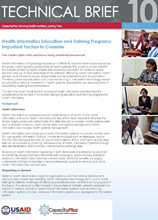
New Publication Spotlight: Health Informatics Education and Training Programs: Important Factors to Consider
What does the field of health informatics have to do with health workers? A new CapacityPlus technical brief explains that health informatics—the process of making health-related data accessible and useful for decision-making—is of growing importance in efforts to improve health outcomes across the globe, and makes the case that health workers must be able to use a number of different computerized resources and tools in their daily work for patient care and health service management, as well as access relevant data and be comfortable with its application. In addition, policy- and decision-makers in the health sector need up-to-date data on the health workforce and population health needs in order to plan and manage a workforce that is capable of responding to local health needs. Therefore, education and training in information technology should be part of the national investment in health systems. In Health Informatics Education and Training Programs: Important Factors to Consider, authors Kate Tulenko, Dykki Settle, and Rebecca Bailey of IntraHealth International introduce the concept of health informatics and describe the considerations to be kept in mind when designing education and training programs for health informatics. They highlight specific factors grouped into four areas:
In Health Informatics Education and Training Programs: Important Factors to Consider, authors Kate Tulenko, Dykki Settle, and Rebecca Bailey of IntraHealth International introduce the concept of health informatics and describe the considerations to be kept in mind when designing education and training programs for health informatics. They highlight specific factors grouped into four areas:
- Policy and administration
- Pipeline
- Curriculum
- Infrastructure.
CapacityPlus routinely supports country efforts to build capacity in health informatics. These capacities can include preservice and in-service eHealth literacy programs for health workers and the development of dedicated health informatics personnel as well as national health informatics capacity-building strategies and policies.
To learn more, read the technical brief—available as an interactive version and a PDF. And please let us know what you think; we welcome your feedback.
Help CapacityPlus spread the word about strengthening the health workforce. Follow us on Twitter and like us on Facebook.
Related items:


